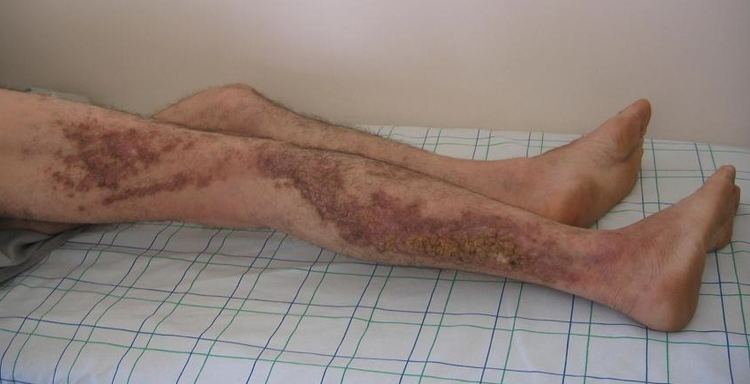Specialty medical genetics ICD-9-CM 757.39 DiseasesDB 3467 | ICD-10 Q82.8 (ILDS Q82.868) OMIM 124200 eMedicine derm/209 | |
 | ||
Darier's disease (DAR), also known as Darier disease, Darier–White disease, Dyskeratosis follicularis and Keratosis follicularis, is an autosomal dominant disorder discovered by French dermatologist Ferdinand-Jean Darier. Darier's is characterized by dark crusty patches on the skin, sometimes containing pus. The crusty patches are also known as keratotic papules, keratosis follicularis or dyskeratosis follicularis.
Contents
Mild forms of the disease are the most common, consisting solely of skin rashes that flare-up under certain conditions such as high humidity, high stress or tight-fitting clothes. Even in mild forms, short stature combined with poorly formed fingernails containing vertical striations are diagnostic.
Characteristics
Darier disease affects both men and women and is not contagious. The disease often starts during or later than the teenage years, typically by the third decade. Short stature is common. The symptoms of the disease are thought to be caused by an abnormality in the desmosome-keratin filament complex leading to a breakdown in cell adhesion.
Worldwide prevalence is estimated as between 1: 30,000 and 1: 100,000. Case studies have shown estimated prevalence by country to be 3.8: 100,000 in Slovenia, 1: 36,000 in north-east England, 1: 30,000 in Scotland, and 1: 100,000 in Denmark
It most commonly affects the chest, neck, back, ears, forehead, and groin, but may involve other body areas. The rash associated with Darier's disease often has a distinct odor. Palms & soles may become thickened, intra oral papules can be found. Finger nails become fragile and this helps in diagnosis of the disease. The rash can be aggravated by heat, humidity, and exposure to sunlight. In some cases, sunlight makes it better, especially in the forehead.
Minor forms of the disease are the most common, and may remain undiagnosed throughout life. These consist mainly of minor rashes without odor that are aggravated by heat, humidity, stress and sunlight. Poorly formed fingernails containing vertical striations are diagnostic.
A recent study examined neuropsychiatric conditions in a non-random sample of 100 British individuals assessed as having DAR. There were high lifetime rates for mood disorders (50%), including depression (30%), bipolar disorder (4%), suicidal thoughts (31%) and suicide attempts (13%), suggesting a possible common genetic link. Scattered case studies also suggest a possible link to learning disorders (not yet confirmed).
Genetics
Darier disease is inherited in an autosomal dominant manner, which indicates that the defective gene responsible for a disorder is located on an autosome, and only one copy of the gene is sufficient to cause the disorder, when inherited from a parent who has the disorder.
The disorder is caused by a mutation in the gene ATP2A2. Family members with confirmed identical ATP2A2 mutations can exhibit differences in the clinical severity of disease, suggesting that other genes or environmental factors affect the expression of Darier's disease. With the discovery of the ATP2A2 gene, performing genetic tests to confirm the diagnosis of Darier's disease is now possible.
Treatment
Treatment of choice for severe cases is oral retinoids. During flares, topical or oral antibiotics may be administered. Ciclosporin and prescription-only topical corticosteroids, e.g., betamethasone, have been used during acute flares. Some patients are able to prevent flares with use of topical sunscreens and oral vitamin C.
For minor forms, no specific treatment is required, but avoidance of excessive heat, humidity, stress and tight-fitting clothes is advised, as well as maintaining good hygiene. Topical creams (as above) are occasionally required to deal with flare-ups.
Prognosis
A 1992 study of 163 affected persons found that most patients had no other medical problems and most manage to lead a relatively normal life.
